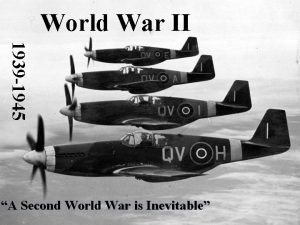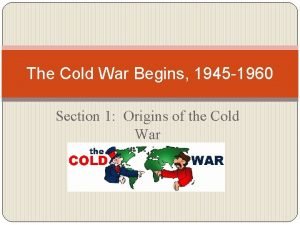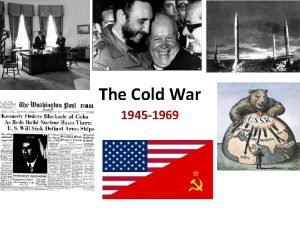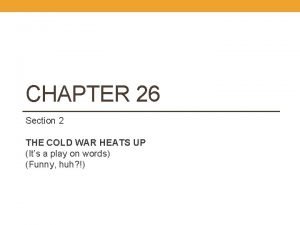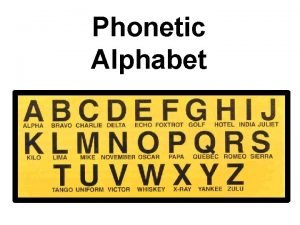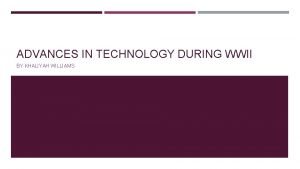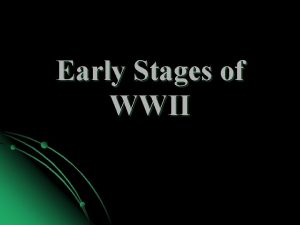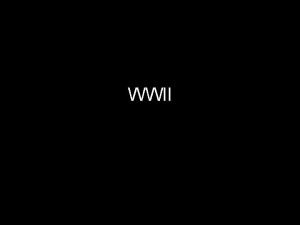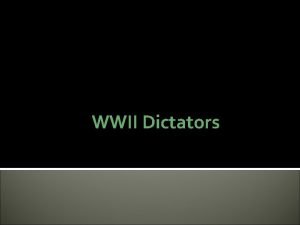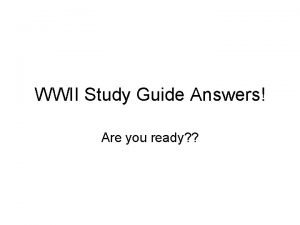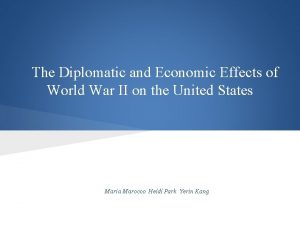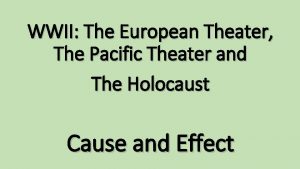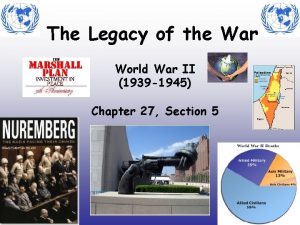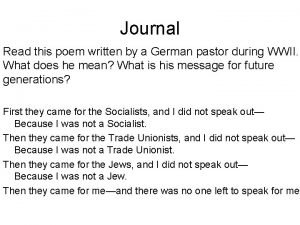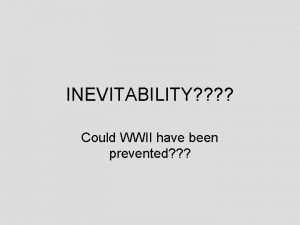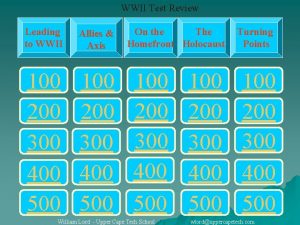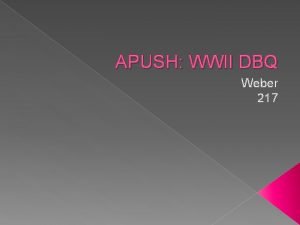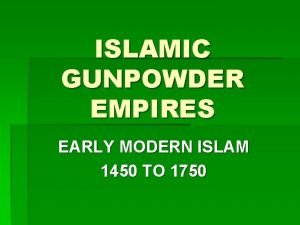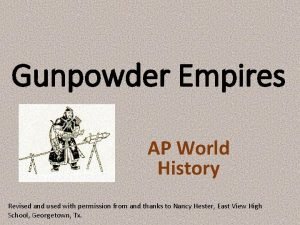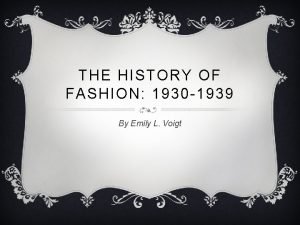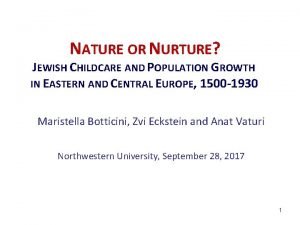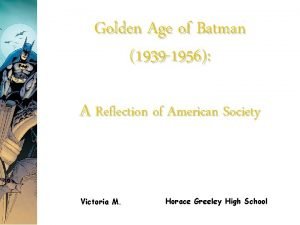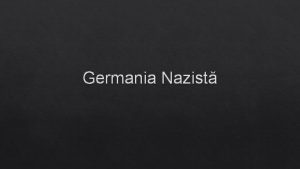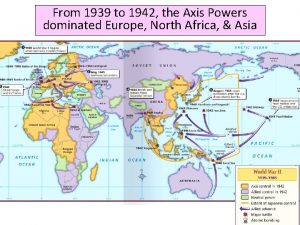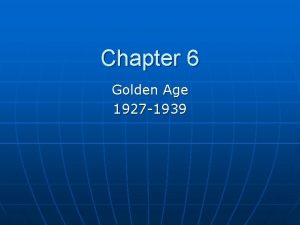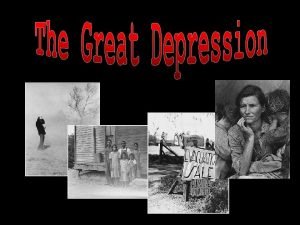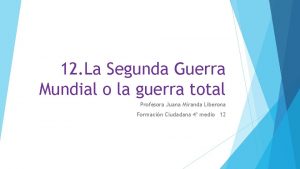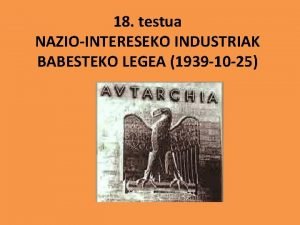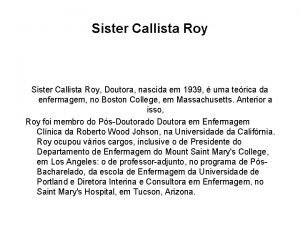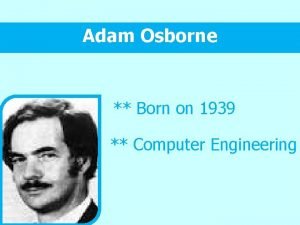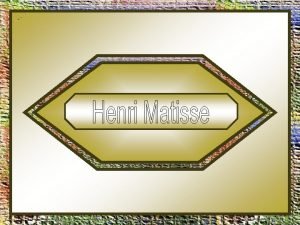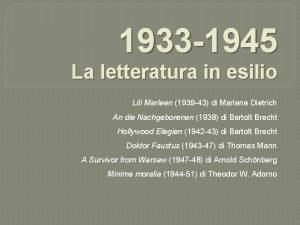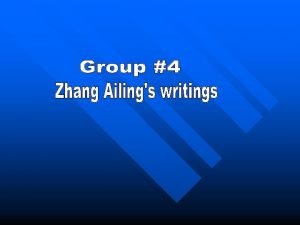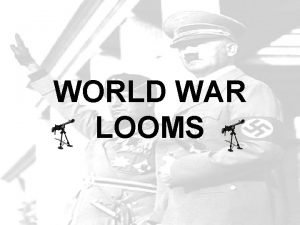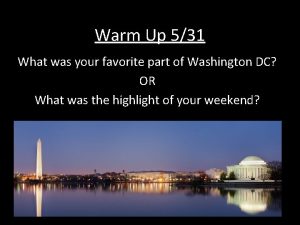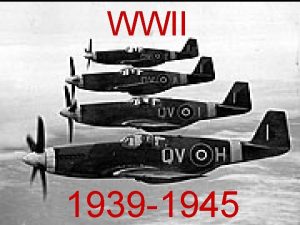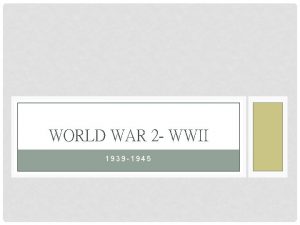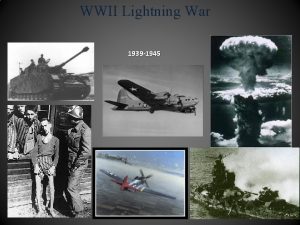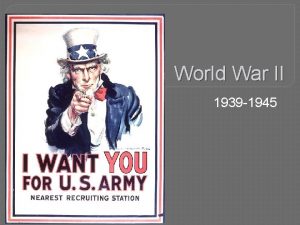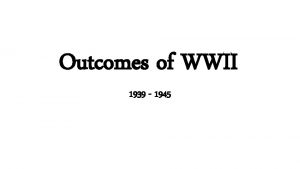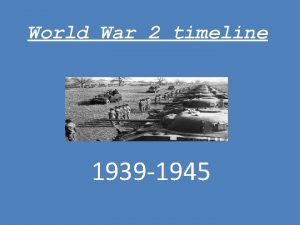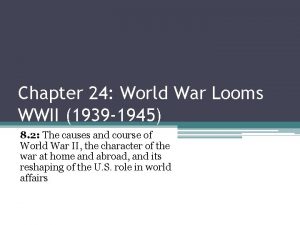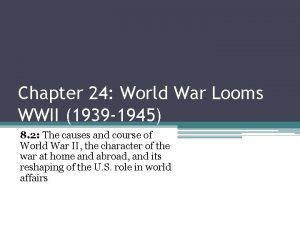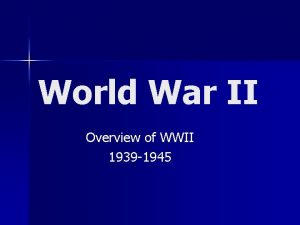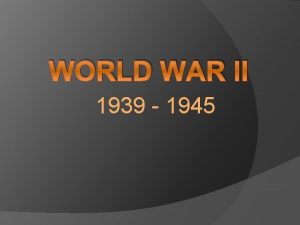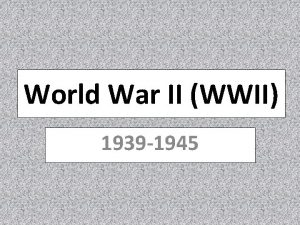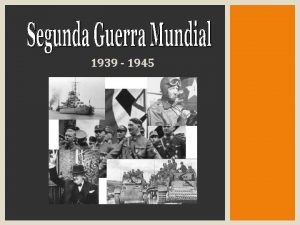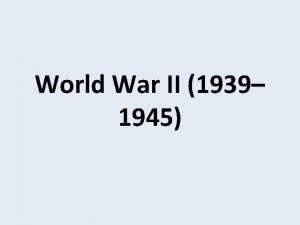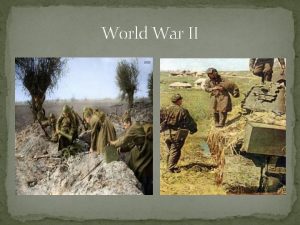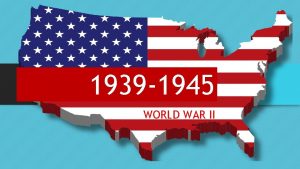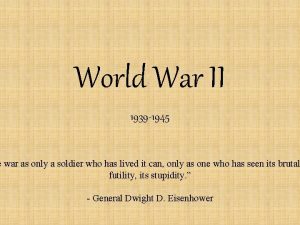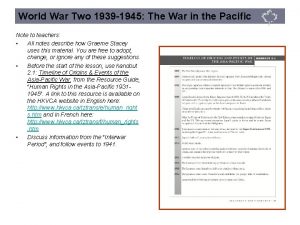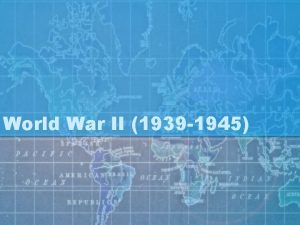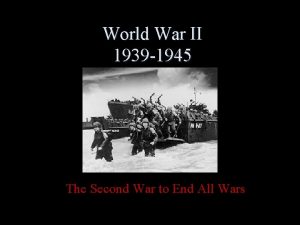World War II WWII 1939 1945 Expanding Empires












































- Slides: 44

World War II WWII 1939 -1945

Expanding Empires n n n In the 1930’s, Japan, Italy, Russia, and Germany began taking over other countries to expand their empires. The U. S. and other countries around the world did not try to stop the fighting. Each of these countries resented the terms of the Treaty of Versailles, signed after WWI. • Germany – was angry about having to repay the costs of WWI and the loss of land they had gained. • Italy – was dissatisfied with the amount of land it gained. • Japan – was disappointed about not getting control of China. • Russia – wanted to take control of Poland

The Rise of Dictators n n n Fascism is a form of government in which individual freedoms are denied and complete power is given to the government. A dictator is a leader who gains complete control of a country’s government. World changes began with the expansion of empires and the rise of dictators around the world: • • • Germany – Adolph Hitler Italy – Benito Mussolini Japan – Hirohito Spain – Francisco Franco Russia – Joseph Stalin

The Axis Powers n n n In 1936 Hitler (Germany) and Mussolini (Italy) signed a treaty to support each other. Japan later joined this alliance. Germany, Italy, and Japan became known as the Axis Powers. At first, the Soviet Union was part of the Axis because they had signed an agreement with Hitler so he wouldn’t invade them. When Hitler went against the agreement, the Soviet Union joined the Allies.

Key Leaders for the Axis Powers n n n Adolph Hitler – Nazi leader of Germany Hirohito- Emperor of Japan General Tojo –military leader of Japan Benito Mussolini – leader of the Fascist party in Italy Joseph Stalin- dictator of the Soviet Union (until 1941)

Germany n n n Germany was the aggressor in expanding their empire first. Germany had suffered economically after WW I and during the global depression. The people of Germany wanted a strong leader who could make their country powerful, like it was before WW I.

January 1933: Hitler became Chancellor of Germany

Hitler’s Views n n Hitler became leader of a political party called the Nazis. The Nazis developed a powerful army. Hitler blamed Jews for many of Germany’s problems, so he made life hard for Jewish people in Germany. The Nazis began to round up Jews and people who did not agree with them to put them in terrible prisons called concentration camps. Hitler was especially dangerous in his ideas. He believed that only Germans with blond hair and blue eyes were “true Germans”. He dreamed that Germany would one day rule the world.

August 1939: Germany and Russia signed a non-aggression pact Hitler and Stalin (the Russian leader) signed a ‘nonaggression pact’. They promised that neither country would attack the other in the event of war. As part of the deal, Hitler promised Stalin part of Poland, which he planned to invade soon. This photo shows the Russian foreign minister signing the pact, whilst Stalin stands smiling in the background

Expansion n From April 1940 -December 1941, the Axis Powers continued across Europe, North Africa, and the Pacific islands to conquer other lands. At this time, Hitler broke his agreement with the Soviet Union and began to invade Russia. Stalin joined the Allies to get help in stopping Germany from taking over.

The Allied Powers n n n Britain and France , known as the Allied Powers, or Allies, promised to protect Poland. They warned Hitler that if he attacked Poland, it would mean war with the Allies. Australia, New Zealand, South Africa, Canada, and many other smaller countries also joined the Allies.

The Big Three Stalin, Roosevelt, Churchill

Key Leaders for the Allied Powers n n Winston Churchill – Prime Minister of Great Britain President Roosevelt – U. S. President Truman – U. S. President after Roosevelt who decided to use the atomic bomb on Japan Joseph Stalin – Soviet Premier of Russia (joined after 1941)

Isolationism n n n Americans read news of the war in their newspapers. German planes were bombing London and other British cities every night. The leader of the British government, Winston Churchill, urged President Roosevelt to help Great Britain. Most Americans wanted the government to focus on the Great Depression. Many Americans had strong support for the policy of isolationism. Isolationism is a policy in which a nation prefers to remain neutral and let other countries handle their own problems.

Japan attacks the U. S. n Japan bombed Pearl Harbor, Hawaii on December 7, 1941. • Most of the Navy’s Pacific fleet of ships were sunk or burned. • More than 300 planes had been damaged or destroyed. • More than 2, 000 sailors and soldiers and 68 civilians were killed in the attack at Pearl Harbor. • Americans were angry, and they no longer objected to Roosevelt’s preparations for war.

Damage to Pearl Harbor

Declaring War n n n The United States entered World War II after Japan bombed Pearl Harbor. Congress declared war on Japan the day after the attack on Pearl Harbor. Three days later, Japan’s two allies, Germany and Italy, declared war on the United States.

The Draft n When the United States entered World War II, the country was not prepared for a major war. • To raise an army quickly, the draft was created. Men between 21 – 39 years old had to register for military service. • The U. S. also started making tanks, bombers, and other war supplies. • Weapons, tanks and supplies were sent to help the Allies.

The Depression Ends n n n President Roosevelt called on factory owners and workers to put their energy into making military equipment. Automobile companies stopped making cars and started making tanks and military trucks. Shipyards operated 24 hours a day building ships. The U. S. Airplane industry became the biggest industry in the world by 1945. As factories expanded to produce all the military equipment, this created millions of new jobs. As a result, the Great Depression finally came to an end.

New Jobs for Women n n n More than 350, 000 women served in the military during World War II. Women worked as nurses, airplane pilots, radio operators, and mechanics. Because millions of men had left their jobs to serve in the military, the U. S. had a shortage of workers. Women helped solve this shortage by going to work in factories to make weapons and other war-related products. “Rosie the Riveter” became a symbol of women who kept American factories running during the war. 7 million women joined the workforce.

Women in the Military

“Do Your Part” n n n Posters and radio commercials urged Americans to “Do Your Part. ” There were many things people of all ages could do to help the war effort. Children collected scrap metal. The U. S. government limited the amount of food each person in the U. S. could buy. This is called rationing. Americans planted victory gardens in backyards and on the rooftops of apartments to increase the amount of food available.

New Opportunities for African Americans n n Factories needed all the workers they could get. This created new jobs for African American men and women. During World War II, most black and white soldiers served in segregated military units. By the end of the war, some African Americans were serving in integrated units. More than one million African Americans served in the military in World War II. African American pilots trained at an army base in Tuskegee, Alabama. They were called the Tuskegee Airmen.

Integrated Military Unit

Japanese Americans n n About 125, 000 Japanese Americans lived in the United States in 1941. Many Americans worried that Japanese Americans might help Japanese Americans were forced to leave their homes and move to relocation camps – also called internment camps – around the U. S. Thousands of Japanese Americans were held in these camps until the end of the war.

Japanese Relocation Camps

Technology and War n n n Scientists competed to invent new tools that could help their side win the war. Albert Einstein was a Jew who escaped from Germany after Hitler rose to power. He was living in the U. S. In 1939, Einstein told President Roosevelt that it might be possible to build an extremely powerful bomb that would create massive explosive energy by splitting atoms. In 1942, the U. S. government started the Manhattan Project. This was the code name given to the effort to build an atomic bomb. Codes were vital during the war. By breaking the enemies’ codes, the Allies would know what their next move would be. Radar was used to determine the location of objects such as airplanes or ships. This helped fighter pilots shoot down hundreds of German planes.

Albert Einstein

WWII – Changes in Warfare n n n n WWII was a new kind of war. Soldiers did not fight from trenches as they had in World War I. Soldiers moved quickly by tank, ship or airplane. Ships carried aircraft; soldiers parachuted from aircraft. Anti-aircraft guns were used. 2 -way radios were used on the battle field. Bombs dropped in air raids destroyed factories, hospitals, and homes. Better medicine for the wounded.

American Soldiers n n More than 16 million Americans served in the military during World War II. Many soldiers had never been away from home before. The only way to keep in touch with their families was by writing letters. Millions of soldiers were the children of immigrants. This turned out to be an advantage. In any group of soldiers, there was often at least one who spoke German, Italian, French, Russian, Spanish, or Japanese. This was helpful for an army that was fighting all over the world. A group of Navajo soldiers known as “Code Talkers” used their language to create an unbreakable secret code. The Navajo Code Talkers took part in many major battles against Japanese forces.

Navaho Code Talkers

Major Turning Points n Battle of Midway was a major turning point in the war against Japan. • Flying planes called “dive bombers” destroyed four Japanese aircraft carriers and many other ships and planes. • After this, Japan’s navy was no longer strong enough to continue capturing islands in the Pacific and the U. S. began to win territory back from Japan. • Battle of Stalingrad was a major turning point in the Soviet Union against Germany. • Hitler’s goal was to take over the industrial city of Stalingrad, but the Soviet Army was able to hold them off. After this, the German army began to retreat. • Battle of the Bulge was the largest battle fought by the U. S. Army. • The Allies crossed into the border of Germany from one direction while the Soviet Union entered Germany from the other. • This final battle led to the defeat of Germany and the death of Hitler.

D-Day n n n The Allies planned an invasion of Europe. June 6, 1944 was known as D-Day was the date the Allies worked together in the largest water-to-land invasion in history. On D-Day 600 warships and 4, 000 landing craft carried 176, 000 soldiers across the English Channel, and they landed on the beaches of Normandy, France. Many soldiers died on D-Day, but the invasion was successful.


Important Dates of WWII n n June 6, 1944 – D-Day (largest invasion by sea) May 87, 1945 - VE Day (Victory in Europe) August 15, 1945 - VJ Day (Victory in Japan) September 2, 1945 - official day of Japanese surrender

War in Asia n n American’s celebrated Victory in Europe, but the U. S. was still battling a determined Japanese army. American General Douglas Mac Arthur planned to fight Japan using a strategy called “island hopping. ” In February 1945, the U. S. invaded the small Pacific Island of Iwo Jima, Japan. Then, American forces attacked Okinawa, Japan. Military leaders were planning to attack the mainland of Japan, but they feared that it might cost as many as one million American lives. On April 12, 1945, President Roosevelt suddenly died, and Vice President Harry S. Truman took the oath of office to become the President.

Iwo Jima

The Atomic Bomb n n n After he took office, President Truman learned that President Roosevelt had agreed to the development of the most powerful bomb in the world. By the summer of 1945, the atomic bomb was ready, and President Truman made the difficult decision to drop the atom bomb on Japan. Truman wanted to end the war and save American lives. On August 6 and 9, 1945, the US dropped atomic bombs on 2 cities in Japan. (Hiroshima and Nagasaki) Japan surrendered after the atomic bombs.

Atomic Bombs in Japan

The Holocaust n n n During WWII, many people knew that Hitler and the Nazis had been putting people in concentration camps, but only when the war was over in Europe did people discover how cruel Hitler and the Nazis had been. 6 million people were murdered simply because they were Jews. Historians call this the Holocaust, a word meaning “widespread destruction. ” 6 million non-Jewish people were also murdered in concentration camps. These were the elderly, Polish people, gypsies, those who disagreed with the Nazis, any who helped the Jews, and many others.

Holocaust

Anne Frank n n n A Jewish girl named Anne Frank was living in the Netherlands when World War II began. In 1942 German soldiers began arresting Jews in the Netherlands and sending them to concentration camps. Ann and her family hid in a secret place above Anne’s father’s office. Anne was 13 years old when she and her family moved into their hiding place. In her diary she described her life in hiding. German police found Anne’s hiding place in 1944. Anne and her family were arrested and she died in a concentration camp in Germany just two months before the end of the war. Anne Frank’s diary was later found in the hiding place, and it has become one of the most famous accounts of life under Nazi rule.

Anne Frank

Results of WWII The Costs of the War n n n Over 40 to 50 million soldiers and civilians died from around the world. More than 400, 000 American soldiers died in World War II. The world now faced a massive rebuilding job. The world now faced the threat of a new kind of weapon – the atomic bomb. Germany was defeated and was divided by the Allies. East Germany became a Communist country and West Germany became a democratic Country. Japan was defeated and became more of a democratic country.
 How were land based and maritime empires similar
How were land based and maritime empires similar 1945 world war ii
1945 world war ii 1945 world war
1945 world war The cold war begins 1945-1960
The cold war begins 1945-1960 The cold war heats up: 1945 - 1969
The cold war heats up: 1945 - 1969 Chapter 26 section 2 the cold war heats up answer key
Chapter 26 section 2 the cold war heats up answer key Ww2 military alphabet
Ww2 military alphabet Advances in technology during wwii
Advances in technology during wwii Nye commission
Nye commission Wwii picture
Wwii picture Wwii picture
Wwii picture Wwii study guide
Wwii study guide Second world war effects
Second world war effects Wwii show
Wwii show 1500 dead in hawaii congress votes war
1500 dead in hawaii congress votes war Causes of ww2
Causes of ww2 Nazi germany
Nazi germany Wwii
Wwii Could wwii have been prevented
Could wwii have been prevented Wwii test review
Wwii test review Apush wwii dbq
Apush wwii dbq Tamerlame
Tamerlame Gunpowder ap world history
Gunpowder ap world history Dubai population pyramid
Dubai population pyramid 1930-1939 fashion
1930-1939 fashion Revolutionary leaders 1900-1939
Revolutionary leaders 1900-1939 Poland population 1939
Poland population 1939 Varför kallas perioden 1918-1939 för mellankrigstiden
Varför kallas perioden 1918-1939 för mellankrigstiden The golden age (1939-1956)
The golden age (1939-1956) Harta germaniei 1939
Harta germaniei 1939 Who dominated europe, north africa and asia from 1939-1942?
Who dominated europe, north africa and asia from 1939-1942? Golden age of aviation 1927-1939
Golden age of aviation 1927-1939 1939 market crash
1939 market crash Mapamundi 1939
Mapamundi 1939 1939
1939 18 testua iruzkina
18 testua iruzkina Teoria da adaptação callista roy slide
Teoria da adaptação callista roy slide Computer 1939
Computer 1939 Stefan gerken
Stefan gerken Henri matisse la musique 1939
Henri matisse la musique 1939 Lili marleen 1939
Lili marleen 1939 Eileen chang love in a fallen city summary
Eileen chang love in a fallen city summary St. louis ship 1939
St. louis ship 1939 Concentration camps vs internment camps venn diagram
Concentration camps vs internment camps venn diagram Lane raporu sosyal hizmet
Lane raporu sosyal hizmet

